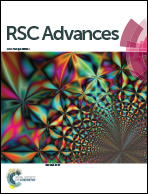Synthesis, growth mechanism and photocatalytic H2 evolution of CdS/CuS composite via hydrothermal method
Abstract
In recent years, visible light-driven photocatalysts used for confronting energy shortages and environmental pollution have drawn much attention. CdS is regarded as an excellent photoelectric semiconductor for photocatalysis, but photocorrosion and low photocatalytic activity limit its practical application. In order to improve the photocatalytic performance of CdS, we synthesized a II-type CdS/CuS composite via a hydrothermal method in one step. CdS, CuS and the CdS/CuS composite have flower-like structures according to FESEM results. XRD and EDS results confirm that the composite is composed of CdS and CuS, indicating that we have successfully synthesized the CdS/CuS composite. UV-Vis and PL results show that the formation of heterojunction structures with CuS can be used to control the optical properties of CdS. H2 evolution results show that the CdS/CuS composite generates H2 at a rate of 295 μmol g−1 h−1, which is higher than that of CdS.



 Please wait while we load your content...
Please wait while we load your content...